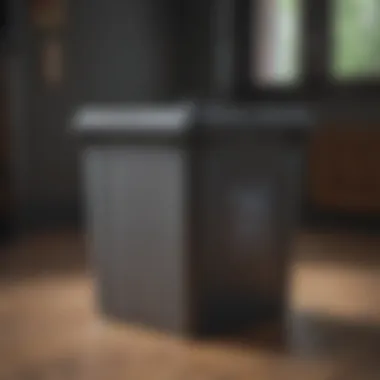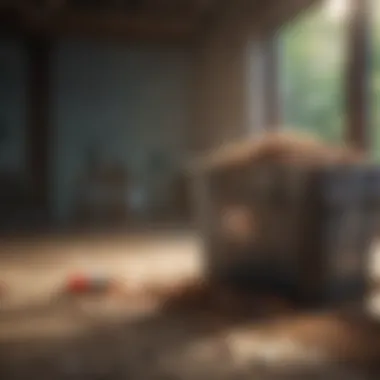Expert Guide on Safe Needle Bin Disposal Methods and Best Practices


Overview of the Topic
Needle bin disposal is a critical aspect of managing medical waste to prevent health and environmental hazards. This guide delves into the safe and proper methods of disposing of needle bins, emphasizing the importance of following regulations and best practices to mitigate risks efficiently.
Current State and Challenges
The current state of needle bin disposal presents significant challenges due to improper handling, leading to the potential spread of infections and environmental pollution. Lack of adherence to proper disposal methods poses threats to public health and the ecosystem, demanding urgent attention and effective solutions.
Sustainable Solutions
Exploring sustainable solutions for needle bin disposal involves implementing proper waste segregation, utilizing designated disposal facilities, and employing safety measures to protect waste handlers and the environment. Successful case studies showcasing efficient resource management demonstrate the efficacy of following sustainable practices in medical waste disposal.
Impact and Importance
The impact of negligent needle bin disposal extends beyond immediate repercussions, affecting ecosystems, communities, and future generations. Emphasizing the importance of conservation efforts and responsible waste management practices is crucial to safeguarding public health and preserving environmental integrity.
Introduction to Needle Bin Disposal
In today's world, the safe disposal of needles and sharps waste has become a critical issue that demands attention. Proper needle bin disposal is not just a mundane task but a vital aspect of public health and environmental safety. This comprehensive guide on needle bin disposal will delve deep into various methods, regulations, and best practices necessary to mitigate the risks associated with improper disposal.
Understanding the Importance of Proper Needle Disposal
Health Risks Associated with Improper Disposal


When needles are not disposed of properly, there is a significant risk of transmitting infectious diseases such as HIV, Hepatitis B, and Hepatitis C. Improper disposal of needles poses a direct threat to public health as it can lead to the spread of these dangerous infections. Highlighting the gravity of health risks associated with improper needle disposal underscores the urgency of handling this issue with utmost care and responsibility, making it a focal point of concern within the broader topic of needle bin disposal.
Environmental Impact of Inappropriate Needle Disposal
The improper disposal of needles not only poses risks to human health but also has severe implications for the environment. Discarded needles can potentially contaminate soil and water sources, introducing harmful substances into the ecosystem and endangering wildlife. The environmental impact of inappropriate needle disposal is a critical consideration that emphasizes the interconnectedness of public health and environmental well-being within the context of needle bin disposal.
Regulations and Guidelines for Needle Disposal
FDA Regulations on Sharps Disposal
The FDA has stringent regulations in place governing the disposal of sharps, including needles, to protect healthcare workers, patients, and the general public from hazards associated with needle stick injuries. Compliance with FDA regulations on sharps disposal is imperative to ensure the safe handling and proper disposal of medical waste. Understanding the specific requirements set forth by the FDA is essential for upholding best practices in needle disposal and safeguarding all individuals involved in the process.
Guidelines for Safe Needle Disposal
The CDC provides comprehensive guidelines for the safe disposal of needles to prevent injuries and infections. These guidelines offer clear instructions on proper needle disposal techniques, emphasizing the importance of using puncture-resistant containers and securing needle lids to prevent accidental exposure. Adhering to CDC guidelines for safe needle disposal is paramount in reducing the risks associated with handling sharps and maintaining a secure and hygienic disposal process.
Methods of Needle Bin Disposal
In the comprehensive guide to needle bin disposal, the section on Methods of Needle Bin Disposal plays a critical role in highlighting various techniques and strategies for safely disposing of sharps waste. This section delves into the significance of proper disposal methods in minimizing health risks and reducing environmental impact. By exploring specific elements such as drop-off locations, mail-back programs, and needle destruction devices, readers can gain valuable insights into the best practices for managing needle disposal effectively and responsibly.
Drop-Off Locations for Needle Bins
Hospitals and Clinics


Discussing hospitals and clinics in the context of needle bin disposal is essential for understanding their pivotal role in providing accessible disposal options for individuals. These institutions serve as key locations where individuals can drop off used needles and sharps safely, contributing significantly to public health and safety. The convenience and reliability of hospitals and clinics make them a popular choice for proper needle disposal. Their regulated waste management systems ensure that sharps waste is securely collected and managed, offering a beneficial and practical solution for individuals seeking safe disposal methods.
Pharmacies
Pharmacies also play a crucial role in needle disposal by offering convenient drop-off services for sharps waste. The key characteristic of pharmacies lies in their community presence, making them easily accessible to a wide range of individuals. This accessibility, coupled with proper disposal protocols, makes pharmacies a beneficial choice for needle disposal. However, limited operating hours and capacity constraints may pose challenges in some locations, affecting the efficiency of disposal services.
Community Collection Programs
Community collection programs serve as inclusive platforms for needle disposal, engaging local residents in proper sharps waste management. The key characteristic of these programs is their community-driven approach, promoting collaboration and responsibility among participants. By establishing designated collection points in neighborhoods, community collection programs offer a convenient and communal solution for needle disposal. While these programs foster community engagement and awareness, logistical issues and sustainability challenges may impact their long-term effectiveness.
Mail-Back Programs for Needle Disposal
Safe and Convenient Option for Disposing of Sharps
Mail-back programs provide a safe and convenient option for disposing of sharps waste, catering to individuals who prefer a more discreet disposal method. The key characteristic of mail-back programs is their simplicity and efficiency, allowing users to mail their filled sharps containers for proper disposal. This approach ensures compliance with regulations and promotes responsible needle disposal practices. However, factors such as associated costs and transportation logistics may influence the accessibility and uptake of mail-back programs among certain demographics.
Needle Destruction Devices
Usage and Effectiveness of Needle Destroyers
Exploring the usage and effectiveness of needle destroyers sheds light on advanced disposal technologies that render sharps waste non-reusable. The key characteristic of needle destruction devices is their ability to safely and permanently deactivate used needles, minimizing the risk of needlestick injuries and contamination. This high level of effectiveness makes needle destroyers a popular choice for healthcare facilities and sharps generators seeking a reliable disposal solution. However, considerations such as initial investment costs and maintenance requirements should be evaluated when implementing needle destruction devices for sharps disposal.
Best Practices for Needle Bin Disposal


In the realm of proper waste management, needle disposal stands out as a critical aspect with significant implications for public health and environmental safety. Emphasizing best practices for needle bin disposal is paramount in ensuring the effective containment and destruction of hazardous sharps waste. By adhering to established guidelines and procedures, individuals and organizations can prevent the spread of infections and the contamination of the environment. Proper needle bin disposal encapsulates a range of specific elements, including safe handling, appropriate packaging, and responsible disposal methods. These practices not only reduce the risk of needlestick injuries but also safeguard communities from potential health hazards.
Safe Handling and Packaging of Needles
Using Puncture-Resistant Containers: When delving into the world of needle disposal, the utilization of puncture-resistant containers emerges as a cornerstone practice. These specialized containers are designed to withstand penetration from sharps objects, offering a reliable means of containment for used needles. Their substantial construction provides a secure barrier that minimizes the risk of accidental punctures during handling and transportation. Puncture-resistant containers are an indispensable component of needle disposal processes, enhancing safety measures and mitigating the danger of needle-related injuries. While ensuring proper containment, these containers also facilitate seamless disposal procedures, reinforcing the overall objectives of safe needle management.
Securing Needle Lids Properly: Another crucial facet of needle disposal revolves around the secure sealing of needle lids. Properly securing the lids on disposal containers is vital in preventing spillage and leakage of hazardous waste materials. By tightly fastening the lids, individuals can effectively contain used needles, reducing the likelihood of exposure to pathogens. Securely closed lids also deter animals and unauthorized individuals from accessing the contents, maintaining a barrier of protection against accidental injuries and environmental contamination. The practice of securing needle lids properly reinforces the responsible management of sharps waste, promoting a safe and hygienic disposal process.
Educating Communities on Proper Disposal Methods
Importance of Public Awareness Campaigns: A fundamental strategy in advancing needle disposal practices involves the education and engagement of communities through public awareness campaigns. By increasing awareness about the importance of proper needle disposal, these initiatives cultivate a culture of responsibility and accountability among individuals. Public awareness campaigns effectively communicate the potential risks associated with improper needle disposal, encouraging community members to adopt safe practices. Through targeted outreach and educational programs, communities can proactively enhance their understanding of sharps waste management, fostering a collective commitment to safeguarding public health and environmental well-being. The emphasis on public awareness campaigns underscores the transformative power of education in promoting responsible needle disposal practices.
Conclusion
The needle bin disposal guide encapsulates the multifaceted facets of safe needle and sharps waste disposal. Understanding the importance of proper disposal is paramount in safeguarding public health and the environment. Compliance with regulations ensures adherence to stringent standards, mitigating risks effectively. Therefore, employing best practices in needle bin disposal is not just a choice; it is the foundation of a responsible approach.
Summary of Key Points
Proper Disposal is Crucial for Public Health and Safety
Proper disposal stands as a cornerstone in preserving public health integrity while reducing environmental hazards. The meticulous handling of sharps and needles minimizes the transmission of infectious diseases and potential injuries. Its efficacy lies in promoting a safe environment for communities and healthcare workers alike. Embracing proper disposal practices is not only beneficial but imperative, safeguarding against severe health consequences and ecological harm.
Compliance with Regulations is Essential
Compliance with regulations signifies a commitment to upholding safety standards and ethical responsibilities. It ensures that disposal methods align with industry guidelines, fostering a culture of accountability and diligence. Following regulatory protocols is advantageous as it streamlines processes and guarantees consistent quality in waste management practices. While compliance demands effort, the long-term benefits outweigh any challenges, establishing a framework for sustainable needle disposal operations.
Final Thoughts on Needle Disposal
Continued Efforts Needed for Safe Needle Disposal Practices
Sustaining safe needle disposal practices necessitates ongoing dedication and community involvement. Education and awareness initiatives play a pivotal role in advocating for responsible waste disposal behaviors. By continuously striving for improvement and innovation in disposal techniques, we enhance public safety and environmental sustainability. Emphasizing the importance of collective efforts cultivates a culture of care and conscientiousness towards the disposal of needles, reinforcing the significance of continual progress in this critical field.



